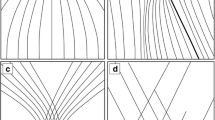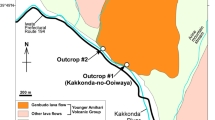Abstract
Entablature is the term used to describe zones or tiers of irregular jointing in basaltic lava flows. It is thought to form when water from rivers dammed by the lava inundates the lava flow surface, and during lava-meltwater interaction in subglacial settings. A number of different fracture types are described in entablature outcrops from the Búrfell lava and older lava flows in Þjórsárdalur, southwest Iceland. These are: striae-bearing, column-bounding fractures and pseudopillow fracture systems that themselves consist of two different fracture types—master fractures with dimpled surface textures and subsidiary fractures with curved striae. The interaction of pseudopillow fracture systems and columnar jointing in the entablature produces the chevron fracture patterns that are commonly observed in entablature. Cube-jointing is a more densely fractured version of entablature, which likely forms when more coolant enters the hot lava. The entablature tiers display closely spaced striae and dendritic crystal shapes which indicate rapid cooling. Master fracture surfaces show a thin band with an evolved composition at the fracture surface; mineral textures in this band also show evidence of quenching of this material. This is interpreted as gas-driven filter pressing of late-stage residual melt that is drawn into an area of low pressure immediately preceding or during master fracture formation by ductile extensional fracture of hot, partially crystallised lava. This melt is then quenched by an influx of water and/or steam when the master fracture fully opens. Our findings suggest that master fractures are the main conduit for coolant entering the lava flow during entablature formation.









Similar content being viewed by others
References
Anderson AT, Swihart GH, Artioli G, Geiger CA (1984) Segregation vesicles, gas filter-pressing, and igneous differentiation. J Geol 92(1):55–72
Bergh S, Sigvaldason G (1991) Pleistocene mass-flow deposits of basaltic hyaloclastite on a shallow submarine shelf, South Iceland. Bull Volcanol 53:597–611
Bron F, Besson J, Pineau A (2004) Ductile rupture in thin sheets of two grades of 2024 aluminum alloy. Mater Sci Eng A 380(1–2):356–364
Costa A, Blake S, Self S (2009) Segregation processes in vesiculating crystallizing magmas. J Volcanol Geotherm Res 153(3):287–300
DeGraff J, Aydin A (1987) Surface morphology of columnar joints and its significance to mechanics and direction of joint growth. Geol Soc Am Bull 99(5):605–617
DeGraff JM, Aydin A (1993) Effect of thermal regime on growth increment and spacing of contraction joints in basaltic lava. J Geophys Res Solid Earth 98(B4):6411–6430
DeGraff J, Long P, Aydin A (1989) Use of joint-growth directions and rock textures to infer thermal regimes during solidification of basaltic lava flows. J Volcanol Geotherm Res 38:309–324
Eichhubl P, Aydin A (2003) Ductile opening-mode fracture by pore growth and coalescence during combustion alteration of siliceous mudstone. J Struct Geol 25(1):121–134
Forbes AES, Blake S, McGarvie DW, Tuffen H (2012) Pseudopillow fracture systems in lavas: insights into cooling mechanisms and environments from lava flow fractures. J Volcanol Geotherm Res 245–246:68–80
Goehring L, Morris SW (2008) Scaling of columnar joints in basalt. J Geophys Res 113(B10):B10203. doi:10.1029/12007JB005018
Greeley R, Fagents SA (2001) Icelandic pseudocraters as analogs to some volcanic cones on Mars. J Geophys Res 106(E9):20527–20546
Grossenbacher K, McDuffie S (1995) Conductive cooling of lava: columnar joint diameter and stria width as functions of cooling rate and thermal gradient. J Volcanol Geotherm Res 69(1–2):95–103
Halldorsson SA, Oskarsson N, Gronvold K, Sigurdsson G, Sverrisdottir G, Steinthorsson S (2008) Isotopic-heterogeneity of the Thjorsa lava—implications for mantle sources and crustal processes within the Eastern Rift Zone, Iceland. Chem Geol 255(3):305–316
Hartley ME, Thordarson T (2009) Melt segregations in a Columbia River Basalt lava flow: a possible mechanism for the formation of highly evolved mafic magmas. Lithos 112(3):434–446
Hull D (1999) Fractography: observing, measuring, and interpreting fracture surface topography. Cambridge University Press, Cambridge
Le Roy G, Embury J, Edwards G, Ashby M (1981) A model of ductile fracture based on the nucleation and growth of voids. Acta Metall 29(8):1509–1522
Lescinsky D, Fink J (2000) Lava and ice interaction at stratovolcanoes: use of characteristic features to determine past glacial extents and future volcanic hazards. J Geophys Res 105(B10):711–723
Lodge R, Lescinsky D (2009) Fracture patterns at lava-ice contacts on Kokostick Butte, OR, and Mazama Ridge, Mount Rainier, WA: implications for flow emplacement and cooling histories. J Volcanol Geotherm Res 185(4):298–310
Long P, Wood B (1986) Structures, textures, and cooling histories of Columbia River basalt flows. Geol Soc Am Bull 97(9):1144–1155
Lore J, Gao HJ, Aydin A (2000) Viscoelastic thermal stress in cooling basalt flows. J Geophys Res Solid Earth 105(B10):23695–23709
Lyle P (2000) The eruption environment of multi-tiered columnar basalt lava flows. J Geol Soc London 157:715–722
Mattsson HB, Caricchi L, Almqvist BS, Caddick MJ, Bosshard SA, Hetényi G, Hirt AM (2011) Melt migration in basalt columns driven by crystallization-induced pressure gradients. Nature Commun 2:299. doi:10.1038/ncomms1298
Mee K, Tuffen H, Gilbert J (2006) Snow-contact volcanic facies and their use in determining past eruptive environments at Nevados de Chillán volcano, Chile. Bull Volcanol 68:363–376
Peck DL (1978) Cooling and vesiculation of Alae lava lake. US Geological Survey professional paper, Hawaii, 935
Phillips JC, Humphreys MCS, Daniels KA, Brown RJ, Witham F (2013) The formation of columnar joints produced by cooling in basalt at Staffa, Scotland. Bull Volcanol 75(6):1–17
Rogan W, Blake, S, Smith I (1996) In situ chemical fractionation in thin basaltic lava flows: examples from the Auckland volcanic field, New Zealand, and a general physical model. J Volcanol Geotherm Res 74(1):89–99
Ryan M, Sammis C (1978) Cyclic fracture mechanisms in cooling basalt. Geol Soc Am Bull 89(9):1295–1308
Sæmundsson K (1970) Interglacial lava flows in the lowlands of southern Iceland and the problem of two-tiered columnar jointing. Jökull 20:62–77
Schipper CI, White JDL, Nichols ARL, Burgisser A, Hellebrand E, Murtagh RM (2012) Incipient melt segregation as preserved in subaqueous pyroclasts. Geology 40(4):355–358
Sen B, Sabale A (2011) Flow-types and lava emplacement history of Rajahmundry Traps, west of River Godavari, Andhra Pradesh. J Geol Soc India 78(5):457–467
Sisson T, Bacon C (1999) Gas-driven filter pressing in magmas. Geology 27(7):613–616
Smellie J (2008) Basaltic subglacial sheet-like sequences: evidence for two types with different implications for the inferred thickness of associated ice. Earth-Sci Rev 88:60–88
Smellie J, McIntosh W, Esser R (2006) Eruptive environment of volcanism on Brabant Island: evidence for thin wet-based ice in northern Antarctic Peninsula during the Late Quaternary. Palaeogeogr Palaeoclimatol Palaeoecol 231(1–2):233–252
Smith JV, Miyake Y, Oikawa T (2001) Interpretation of porosity in dacite lava domes as ductile-brittle failure textures. J Volcanol Geotherm Res 112(1–4):25–35
Spry A (1962) The origin of columnar jointing, particularly in basalt flows. J Geol Soc Aust 8(2):191–216
Swanson DA (1967) Yakima Basalt of the Tieton River area, south-central Washington. Geol Soc Am Bull 78(9):1077–1110
Thordarson T, Höskuldsson A (2002) Iceland. Terra, Harpenden
Tomkeieff S (1940) The basalt lavas of the Giant's Causeway district of Northern Ireland. Bull Volcanol 6(1):89–143
Tucker D, Scott K (2009) Structures and facies associated with the flow of subaerial basaltic lava into a deep freshwater lake: the Sulphur Creek lava flow, North Cascades, Washington. J Volcanol Geotherm Res 185(4):311–322
Tvergaard V (1997) Studies of void growth in a thin ductile layer between ceramics. Comput Mech 20(1):186–191
Vilmundardóttir E, Guðmundsson Á, Snorrason SP (1985) Jarðfræði Búrfells og nágrennis (In Icelandic, summary in English: Geology of the Búrfell area). Náttúrufræðingurinn 54:97–113
Walker GPL (1993) Basaltic-volcano systems. Geol Soc London Spec Publ 76:3–38
Watanabe K, Katsui Y (1976) Pseudo-pillow lavas in the Aso caldera, Kyushu, Japan. J Miner Petrol Econ Geol 71:44–49
Wright TL, Fiske RS (1971) Origin of the differentiated and hybrid lavas of Kilauea volcano, Hawaii. J Petrol 12(1):1–65
Wright TL, Okamura RT (1977) Cooling and crystallization of tholeiitic basalt, 1965 Makaopuhi lava lake, Hawaii. USGS Professional Paper 1004. US Government Printing Office, p 78
Acknowledgments
We would like to thank Susanne Schwenzer and Andy Tindle for help with the electron microprobe, John Watson for help with XRF analyses, and Andy Wilson for assistance with drafting figures. AESF was supported by a NERC PhD studentship and The Open University, and HT is supported by a Royal Society University Research Fellowship. Many thanks to Atilla Aydin and an anonymous reviewer for their comments which have improved this article.
Author information
Authors and Affiliations
Corresponding author
Additional information
Editorial responsibility: M. Manga
Electronic supplementary material
Below is the link to the electronic supplementary material.
Table S1
(XLS 333 kb)
Rights and permissions
About this article
Cite this article
Forbes, A.E.S., Blake, S. & Tuffen, H. Entablature: fracture types and mechanisms. Bull Volcanol 76, 820 (2014). https://doi.org/10.1007/s00445-014-0820-z
Received:
Accepted:
Published:
DOI: https://doi.org/10.1007/s00445-014-0820-z




